NEET Biology Notes For Strategies For Enhancement In Food Production Animal Breeding
A group of animals related by descent and similar in most characters such as general appearance, features, size, and configuration are said to belong to a “breed.” Animal breeding is producing improved breeds of domesticated animals by improving their genotypes through selective mating.
Objectives of Animal Breeding
The main objectives of animal breeding are as follows:
- Improved growth rate.
- Increased production of milk, meat, egg, wool, etc.
- Superior quality of milk, meat, eggs, wool, etc.
- Improved resistance to various diseases.
- Increased productive life.
- Increased or, at least, acceptable reproduction rate, etc.
Methods of Animal Breeding
Two methods of animal breeding are inbreeding and outbreeding (based mainly on the breeding work done with cattle).
Inbreeding
- When breeding is done between animals of the same breed for 4-6 generations, it is called inbreeding, e.g., between the breeds of cows, buffaloes, poultry, etc.
- Inbreeding may be explained by taking an example of cows and bulls.
- Superior cows and superior bulls of the same breed are identified and mated.
- The progeny obtained from such mating are evaluated and superior males and females are identified for fur- ther mating.
- A superior female, in the case of cattle, is a cow that produces more milk per lactation.
- On the other hand, a superior male is a bull that gives rise to superior progeny as compared to that of other males.
- Inbreeding, as a rule, increases homozygosity.
- Thus, inbreeding is necessary if we want to develop a pure-line in any animal.
- Inbreeding exposes harmful recessive genes that are eliminated by selection.
- It also helps in the accumulation of superior genes and the elimination of less desirable genes.
- But continued inbreeding reduces fertility and even productivity.
- This is called inbreeding depression.
- In this condition, the selected animals of the breeding population should be mated with superior animals of the same breed but those which are unrelated to the breeding population.
Read and Learn More NEET Biology Notes
Outbreeding
- Outbreeding is breeding between unrelated animals. It may be between the individuals of the same breed (but not having common ancestors) or between different breeds (cross-breeding) or different species (interspecific hybridization).
- Outcrossing: It is the mating of animals within the same breed but not having common ancestors on either side of their pedigree up to 4-6 generations. The offspring of such a cross is called an outcross. Outcrossing is the best breeding method for animals that are below average in productivity and milk production, growth rate in beef in cattle, etc. Sometimes only one outcross helps to over-come inbreeding depression.
- Cross-breeding. In cross-breeding, the superior males of one breed are mated with the superior females of another breed. Many new animal breeds have been developed by this strategy. It gives better breeds. The cows of an inferior breed may be mated with the bulls of a superior breed to get better progeny. Hisardale is a new breed of sheep developed in Punjab by crossing Bikaneri ewes and Marino rams.
- Interspecific hybridization: In this approach, the male and female animals of two different spe- cies are mated. The progeny obtained from such a mating are usually different from both parental species. But in some cases, the progeny may combine the desirable characters of both the parents. A mule is produced from a cross between female horse (mare) and male donkey. Mules are sturdier than their parents and are well-suited for hard work in mountainous regions.
- Animal husbandry is the science of rearing, improvement, and caring of domesticated animals.
- Although the word “animal” includes any of the various organisms belonging to kingdom Animalia, when we use it in animal husbandry, we mean only those domesticated animals which are reared mostly for economic or for recreation purposes, such as cattle, buffalo, sheep, goat, camel, pig, horse, etc.
- It also includes poultry farming and fisheries.
- Since a long time, animals such as bees and silkworm have been used by humans.
- All the above-mentioned livestock (animals kept for use or profit) has been used by humans for products such as milk, eggs, meat, wool, silk, and honey.
- The word “husbandry” means the management of do- mestic affair.
- The term used in connection with animal husbandry includes proper feeding, breeding, healthcare, hous- ing, etc.
- Domestication of animals probably began during the “hunting and gathering” phase of human civilization.
- As humans realized the importance of domesticating animals for use as beasts of burden and as sources of milk, meat, leather, and fur, the methods of improvement through selective breeding were used.
- Curiously, Old World agriculture employed animals while there is little evidence of the use of animals in the primitive agriculture of the New World.
- Most of the useful animals raised today have evolved from their wild ancestors.
- One of the earliest animals to be domesticated was the dog.
- Starting from a few basic types the wild dog, the wolf, and the jackal-man has produced an amazing variety of breeds. The Eskimos still use huskies to draw sledges.
” class 12 biology ch 9 notes”
Cattle Livestock
- Buffalo in India, termed “water-buffalo” in the Western literature, constitutes the most important species of livestock in India.
- It serves as the primary source of milk-the only dietary animal protein for a majority of Indians.
- Compared to cows, buffaloes (Bubalus bubalus) generally yield more milk of high fat content.
- They also have greater disease resistance and longevity.
- The milk yielding capacity of buffaloes is three times more than cows. Buffalo’s milk is superior to cow’s milk in fat content as well as minerals.
- The cattle are used to draw water from wells.
- Their dung is used as fuel and for the generation of biogas.
- India happens to be one of the largest exporters of leather goods made from cattle hide.
- Horns, hooves, and bones are used to prepare cattle feed and fertilizers.
- Indian cattle are hardy and highly resistant to major diseases.
- Bulls from India are used for cross-breeding with Eu- ropean and American varieties.
- The best Indian cattle breeds are found in the drier parts of the country.
- There are 26 breeds of cattle and 7 breeds of buffaloes which differ in their body colors, horns, and shape of forehead.
- The family of domestic cattle is Bovidae.
- There are two main groups of Bovidae (domestic cattle):
- Bos indicus: It is found in India and Africa. It is also called zebu cattle or humped cattle.
- Bos Taurus: It is found in Europe and North America. It is non-humped cattle.
- The zebu is characterized by the following:
- Presence of prominent hump.
- Upright horns.
- A long face.
- Drooping cars.
- Large and slender legs.
- In the US, zebus are called Brahman cattle.
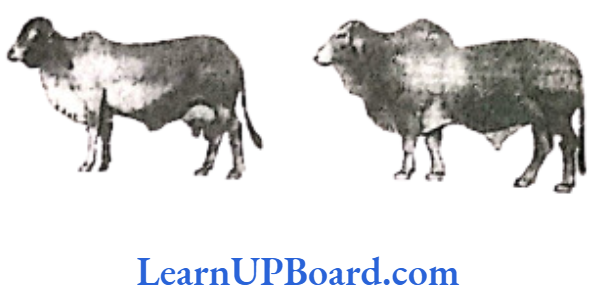
- The cattle breeds are classified into three groups.
- Milch breeds: The cows of these breeds are good milk producers. However, bullocks are of poor quality.
- Draught breeds: The bullocks of these breeds are good for working but cows are poor milk producers.
- General utility breeds (dual-purpose breeds): The cows of these breeds are good milk producers and the bullocks are good draught animals. They are intermediate between milch and draught breeds.
Cross Breeds
- Karan Swiss: This breed has been evolved at the National Dairy Research Institute, Karnal, in Haryana, by breeding the Sahiwal cows with the semen of Brown Swiss bulls imported from the USA.
- Sunandini: This breed originated in Kerala by crossing the local non-descript cattle with Jersey, Brown Swiss, and Holstein-Friesian breeds.
- Karan Fries: This breed originated at the National Dairy Research Institute, Karnal, out of crossing between Tharparkar and Holstein-Friesian.

Cattle of Higher Altitudes
Mithun is found in the north-eastern India at an altitude of 700-1700 m. It is used for meat. Yak is found in Tibet, Ladakh, Lahaul, Spiti, Garhwal, and Sikkim. Yak gives meat, hide, and wool. It is also used for tilling land. The transport of people and goods across the desolate transHimalayan region would be impossible without the yak.
NEET Biology Notes For Strategies For Enhancement In Food Production Cattle Management And Feeding
- India has about 227 million cattle and buffaloes. In terms of sheer numbers, India ranks fifth in the world. However, in milk production, India figures very poorly. Cattle management practices vary in different parts of the country depending upon climatic conditions. India is the lowest in milk yield per cow.
- Feeding: Ninety percent livestock subsists on grazing in public and government-owned lands and forests.
- The prepared feed given to them is classified into the following:
- Roughages: These include fodder, silage, hag, and straw. This feed has a high fiber content.
- Concentrates: These include cereals, millets, forage crops with high leaf protein and oil cake, oil seeds, and animal by-products. Although low in fiber content, the concentrates have high nutrient value and digestibility. Minerals and vitamins are added to the feed of high yielders. The proportion of balanced feed differs for the young and the adult animals.
Cattle-Breeding
- In villages, a few good pedigree bulls are selected on the basis of draught ability and permitted to graze with the cows to bring about random breeding. Bulls not selected for breeding are castrated when young and converted to bullocks. They are the main source of animal draught power in India.
- Mature cattle more than 3 years of age should be used for breeding. The best local cows with a good milk yield should be mated with a pure breed exotic bull which should have high genetic potential. One bull is usually enough for 60 to 70 cows.
- About 10-60% cows are artificially inseminated by semen collected from high-quality bulls. Artificial in- semination ensures good quality progeny and is also economical as semen from a single bull can inseminate several thousand cows. Average gestation period of the cow is 280 days. The length of gestation of buffaloes varies, influenced by breed and environment, between 276 and 340 days, but on an average, it lasts for 310 days (or 10 months), in contrast to the cow with an average gestation of 280 days (or 9 months).
- An average cow or buffalo produces 8-10 calves during its productive lifetime. Generally, only one ovum is fertilized at a time. Selective breeding and progeny testing and improvement take longer time in the live-stock than in annual food crops. With the exception of certain Indian breeds which have been maintained for good yield, the majority of Indian cattle has been on marginal inputs and is infertile and a poor milk yielder. Reasearch on the cause of infertility led to the use of pregnant mare serum gonadotropin to augment fertility in sterile cows and to induce lactation immature females by implantation of stilbesterol tablets.
- Artificial insemination (AI): It involves the insemination of the semen of superior bulls of exotic or indigenous breeds into native cows. The semen should be deposited either deep in the cervix or at the beginning of the body of the uterus. When insemination is performed deep in the cervix, the spermatozoa are likely to live longer in the cervix than in the uterus. The deposition of semen in the vagina results in dilution, contamination, and lowered conception rate. When a bull inseminates a cow naturally, approximately 5-10 billion spermatozoa are deposited in the vagina.
- However, when semen is deposited artificially into the cervix, considerably fewer sperms are required to achieve conception. Therefore, artificial insemination is very economical. Semen collected from a single superior bull can be used for fertilizing many cows. Semen from a desired bull located at a distant place can be used. The spread of certain diseases can be controlled by this method. Artificial insemination was first introduced in India at the Indian Veterinary Research Institute, Izatnagar, near Bareilly, Uttar Pradesh.
- To increase the milk yield, Indian cows are cross-bred with European breeds such as Holstein, Brown Swiss, Jersey, Red Dane, and others. Karan Swiss and Sunandini are the breeds developed through cross-breeding at the National Dairy Research Institute, Karnal, and in Kerala, respectively.
- Super ovulation and embryo transplantation: It is also called MOET (multiple ovulation and embryo transfer). A pedigreed bull and a high-production cow are chosen to produce super milch cows. Super ovulation is induced by hormone injection. After artifical insemination, 4 to 10 embryos are collected at a time. Each embryo is then transplanted into a “carrier” cow (surrogate mother).
- Such embryo transplants can also be carried out in sheep, goats, and other livestock. By deep freezing (-196 ̊C), it is possible to preserve seven days old fetuses for several years to be used when needed. An embryo can be cut into two, to obtain homozygotic twins. The most beneficial outcome of embryo transplantation is the selection of high-quality bulls for genetic upgrading. India has launched research using the above-mentioned techniques.
Use of Buffaloes
Buffaloes provide milk with all the essential nutrients. The milk has big-sized fat globules. It is rich in calcium and phosphorus and is low in sodium and potassium. Buffalo milk is almost free from carotenoids (golden yellow in color) due to the conversion of all carotenoid materials into vitamin A (colorless by the liver cells). Buffalo milk and ghee are white whereas ghee made from cow milk is golden yellow in color because of incomplete conversion of carotenoids into vitamin A inside the liver cells which ultimately appears in cow’s milk.
Cattle Diseases
- Most zebu cattle (domesticated cattle, Bos indicus) are resistant to diseases such as rinderpest or cattle plague and foot and mouth and other bacterial and viral diseases.
- Rinderpest has been controlled through a National Program.
- Vaccination is given to highly productive herds.
- Domesticated animals suffer from a variety of diseases.
- In animals, a disease may be defined as a state of discomfort associated with an abnormal function of the animals’ body.
- Diseases may be caused by mutant genes (genetic diseases), due to improper nutrition, or by pathogens.
- Genetic diseases are strictly selected against animal breeding.
- Generally, animals are raised on properly balanced diets to avoid nutritional disorders and to ensure optimum performance.
- Domesticated animals suffer from diseases caused by (a) viruses, (b) bacteria, (c) protozoa, (d) fungi, and (e) animals such as worms.
- Such diseases are commonly known as infectious dis- eases because these are caused by pathogenic infections.
- Many infectious diseases are known as contagious dis- eases since these spread to healthy animals by contact with diseased animals or with materials that were in direct contact with the diseased animals.
- Some infectious diseases may spread to humans from animals, e.g., anthrax.
- Infections can occur through skin, digestive tract, respiratory tract, conjunctiva, urogenital tract, placenta, umbilicus, udder, teats, and egg.
- It is a good policy to implement measures for the prevention of infectious diseases, some of which are as follows.
- Isolation of animals suffering from or suspected to be infected with an infectious disease.
- Proper disposal of the carcass and all materials that were in contact with the diseased animal(s).
- Proper cleaning and disinfection of the animal house and other materials that were in contact with diseased animal(s).
- Transfer of healthy animals to a pasture other than that used by diseased animal(s).
- Vaccination of animals.
- Injection of antiserum into healthy animals when- ever an epidemic is expected.
- The authorities of the veterinary department should be immediately informed of cases of in- fectious diseases. This will allow them to initiate measures to prevent the spread of these diseases.
Bacterial Diseases
Animals suffer from several bacterial diseases. For example, cattle suffer from anthrax, mastitis, pneumonia, etc.
Anthrax
- Anthrax is caused by the bacterium, Bacillus anthracis.
- This disease is contagious and affects cattle, buffaloes, horse, sheep, and goats; it can also spread to human beings.
- In animals, anthrax spreads through contaminated food, water, and pastures.
Symptoms and Diagnosis
- In very acute cases, there is increased respiration and blood-mixed foamy discharge from mouth, nose, and anus.
- In such cases, the infected animals may die within minutes.
- But in subacute and chronic cases, the infected animals have high fever (up to 41.1°C) and increased pulse and respiration rates.
- There is discharge of black, shiny, and foamy material from the natural openings of animals.
- The infected animals die within 2 to 3 days.
- The anthrax bacterium uses up the oxygen carried by the animal blood.
- As a result, the animals die due to lack of oxygen.
- Disease diagnosis can be confirmed by microscopic observation of the bacterium in the blood of patients or by culturing the bacterium present in the blood on a suitable medium.
Treatment
- In case of human beings, a suitable antibiotic such as ciprofloxacin is quite effective, particularly if used in the initial stages of the disease.
- But in cattle, ciprofloxacin may be effective only in chronic cases.
- Anthrax antiserum can also be used with good results. In any case, antiserum should be given to all healthy animals to protect them from the disease.
Prevention and Control
- The general measures for the prevention of infectious diseases should be followed.
- Healthy animals should be vaccinated.
- Animals that have come in contact with diseased animals should be given anthrax antiserum to protect them from the disease.
Mastitis
Mastitis is the inflammation of udder that often occurs in dry cows due to the infection of bacterium Corynebacterium pyogenes.
Viral Diseases
Animals suffer from a variety of viral diseases. For example, cattle suffer from rinderpest, foot and mouth disease, cowpox, etc. In this section, rinderpest is discussed in detail.
Rinderpest
Rinderpest is caused by a virus. It is highly contagious. The virus is present in all the fluids and secretions of the body of the diseased animal. The disease spreads rapidly by direct contact with the diseased animal, through contaminated food and water, workers and their clothes, and by flies.
Symptoms
- Initially, the infected animal develops fever (40.0-42.2°C), loses appetite, develops constipation, and passes hard feces that are often covered with blood. In the final stages of the disease, the animal suffers from loose motions which give off offensive odor. The body temperature declines and may go down be- low normal. The animal usually dies in about 7 days.
Treatment
Treatment is effective only when it is started in the initial stages of the disease. The injection of sulfamethazine sodium is often effective. The injection of rinderpest antiserum is highly effec- tive, especially when combined with the injection of sulfamethazine sodium.
Prevention
All the measures for the prevention of infectious diseases should be implemented. It is highly desirable to vaccinate the animals against rinderpest. In 1954, a massive vaccination program was initiated in India. This project has been highly successful and rinderpest is no longer a dreaded disease.
Foot and Mouth Disease
- Foot and mouth disease affects cattle, sheep, goats, pigs, and other ruminants. It is caused by ssRNA Aphthovirus and is characterized by the eruption of vesicles over the lips; inside buccal cavity; and over legs, feet, udder, and even teats.
- There is a loss of appetite but dribbling of saliva is present. Lameness occurs.
- The infected animals should be separated immediately and the animal house should be thoroughly disinfected.
class 12 biology chapter 9 notes
Cowpox
- Cowpox is a mild self-limiting eruptive skin disease of cows caused by cowpox virus. The infection is confined to udder and teats.
- It spreads to humans accidently while milking infected animals.
- Inoculum from cowpox lesions was used by Edward Jenner in 1798 as vaccine against smallpox.
NEET Biology Notes For Strategies For Enhancement In Food Production Poultry
- Poultry-farming deals with the rearing of fowls (chicken), ducks, turkeys, and pheasants for their eggs and meat. India and the neighboring countries are recognized as the original home of the red jungle fowl (Gallus gallus). There is evidence that Aseel or Malay fowl were carried to Europe through the Middle East about 2,000 years ago. These have given rise to the present-day European breeds.
- Poultry and poultry products are a rich source of animal protein and other nutrients such as fats, vitamins, and minerals. The consumption of eggs would pave the way for overcoming protein malnutrition prevalent especially among the children in India.
- Poultry-farming has definite advantages over live- stock-rearing. Poultry birds are easy to raise, can be acclimatized to a wide range of climatic conditions, have short lifespan, and are prolific breeders. Hens have an average yield of 60 eggs per year (up to 240 eggs in high-yielding varieties). Poultry-farming requires less space, is easier to manage and maintain, and brings fast returns within a span of 6 months. In a poultry-farm, comfortable, well-ventilated, and illuminated dry houses are built. Birds of different ages are kept in separate houses. In regions with moderate climate, they are kept in cages (coops).
- The floor is littered with chopped straw, paddy husk, dry leaves, or groundnut hulls. It is made rat-proof and is provided with water channels with proper drainage. Minerals that are important for poultry diets are calcium, phos- phorous, sodium, copper, iodine, iron, manganese, and zinc. The vitamins required are vitamin A, B, E, pyridoxine, riboflavin, pantothenic acid, niacin, folic acid, B12, and choline. The male breeder’s diet should contain extra calcium, manganese, and vitamin E to ensure proper fertility. Thus, a balanced diet is the re- quirement so that utilization for the building of tissues and egg production is maximized. Clean and fresh water is very essential for birds.
- Light management: Light is essential for high egg production. 14 to 16 h of light including daylight is required for optimum production. When the pullets (young hens, especially at the time they begin to lay eggs) come into production, start giving additional light if the daylight is less than 12 h. Gradually increase the light 20 min every week till 16 h of total light is there. One tube-light of 40 W is sufficient for 36 m2 area while 40-W-bulb is sufficient for 18 m2 floor area. Light should spread uniformly. It should not be provided for the whole night.
- Fowls are widely distributed as domestic animals. The most common species of jungle fowls are Gallus gallus, G. lafayetti, and G. sonneratti
- Poultry feed includes all the nutrients. It is made of cereals and millets, oil cake, protein concentrates, fish and meat meal, minerals, and green vegetables. The domestic fowl (Gallus domesticus) population of our country can be roughly classified into two types:
- Indigenous (desi type)
- Exotic (improved type)
- Some indigenous breeds such as Aseel, Karaknath, Ghagus, Brahma, and Busra are the best table birds. The Aseel fowls are used in cock-fighting. The exotic breeds are classified, according to their source of origin, into American class, English class, Mediterranean class, and Asiatic class. Some examples are White Leghorn, Rhode Island Red, Plymouth Rock, and New Hampshire. These are now completely acclimatized to Indian conditions. Some of them are excellent egg- layers whereas others give good meat.
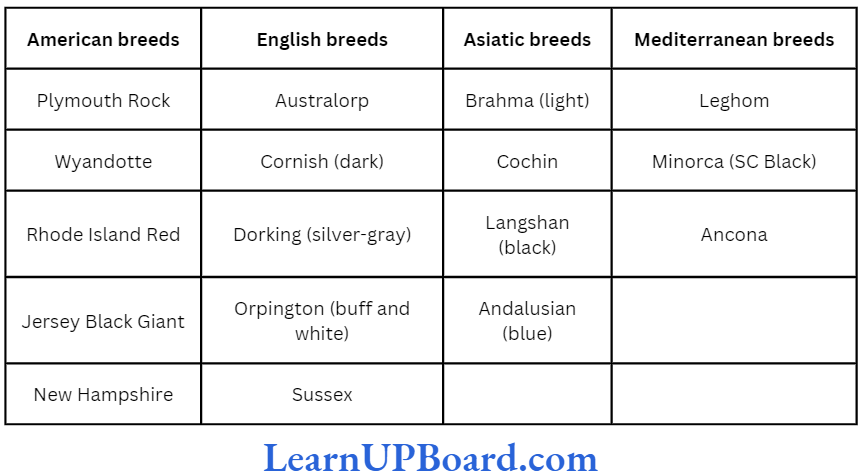
The indigenous breeds are crossed with the exotic breeds for improving egg production. Heterosis has been utilized for producing better egg layers and broilers (birds grown for meat) with high nutritive value.
Some diseases such as fowlpox, Ranikhet, coryza, fowl cholera, and aspergillosis take a heavy toll on poultry. But with better management, proper housing and nutrition, and timely vaccination of the chicks, these diseases can be controlled.
Ducks comprise 6% of the total poultry population in In- dia. They are abundant in the southern and eastern parts of India. There are 20 breeds of duck of which Muscori, Pekin, Aylesbury, and Campbell are popular exotic breeds; indigenous breeds include Indian Runner, Syhelt Meta, etc. Brown and white geese are common in India. Turkeys which are in demand during Christmas time belong to breeds Narfold, British White, Broad Breasted Bronze, and Beltsville Small White.
Poultry Diseases
- Encephalomalacia: Deficiency of vitamin E causes softening of brain tissue in young poultry.
- Coccidiosis: Protozoan Eimeria causes coccidiosis in fowls. It causes bloody diarrhea.
- Bacterial diseases: These are listed in Table 9.4.
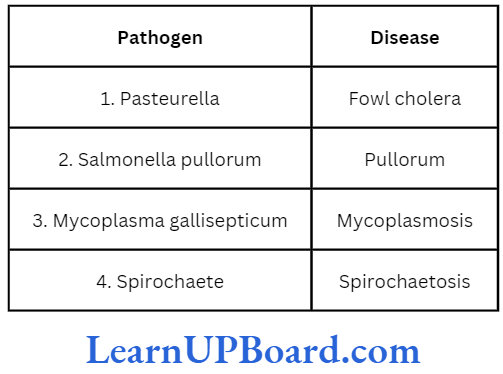
NEET Biology Notes For Strategies For Enhancement In Food Production Apiculture
- Apiculture is the care and management of honey bees. Honey bees give us honey and wax. They are good pollinators.
- The common breeds of honey bee are as follows:
- Apis dorsata (rock bee)
- Apis indica (Indian bee)
- Apis florea (little bee)
- Apis mellifera (Italian bee)
- Honey produced by the honey bee Apis species is probably the oldest sweetening agent in our civilization. Honey contains two sugars-dextrose and levulose and a mixture of several other substances. It is tasty, health-giving, and also medicinally useful. Honey bees also yield wax, which has multiple uses. A large quantity of honey is still collected from wild sources. However, bee-keeping (apiculture) using domesticated bees has been practiced in many parts of the world, including India (using 4. dorsata, A. florae, and A. indica).
- Social organization (castes) of honey bee: The nest of honey bee is known as bee-hive. The hive consists of 32 to 60 thousand individuals, showing a highly organized division of labor in the colony. Bees are polymorphic, consisting of three types of individuals (castes) viz. queen, drone, and worker.
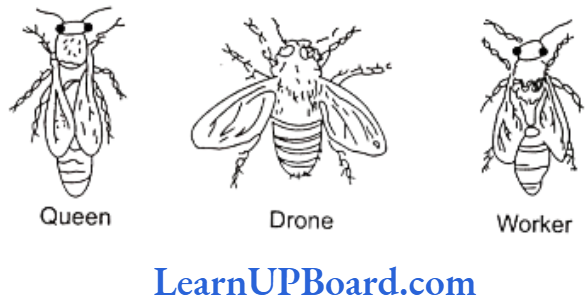
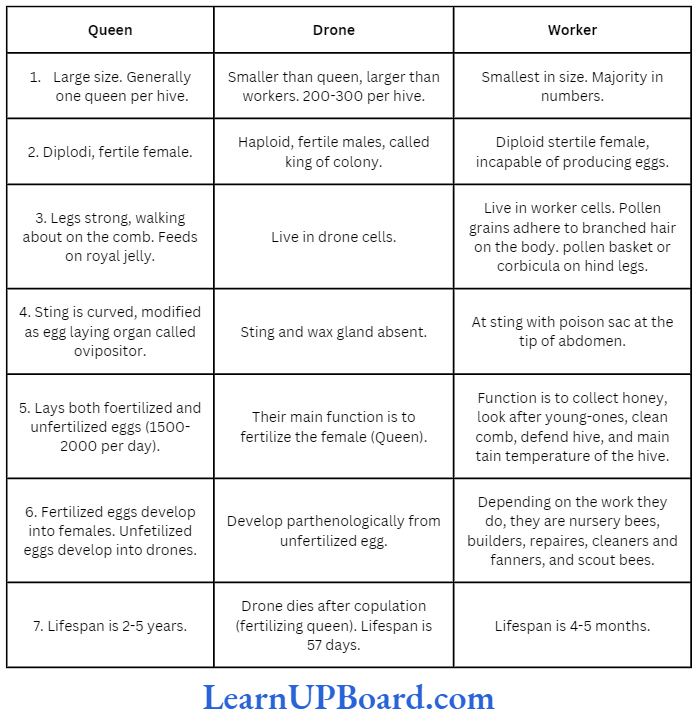
- From its mandibular gland, the developing queen secretes antiqueen substances or antiqueen pheromones which inhibit the worker bees from building brood chambers and developing ovaries.
- Drones are male honey bees. They develop from unfertilized eggs. The phenomenon is called arrhenotoky. Drones and virgin queens take part in nuptial flight. After copulation, the drones are not allowed to come back into hive.
- The queen stores the sperm in her spermatheca. The material is sufficient to fertilize all the eggs that are laid by her.
- Females develop from fertilized eggs. Workers are sterile females. Scout bees search for food and intimate the same to worker bees by dances-round dance for less than 75 m and tail wagging dance for longer distances (Frisch).
- Workers have a pollen collecting apparatus in hind legs called corbicula and nectar storing mechanism in crop and wax secreting glands in abdomen.
- Young workers secrete royal jelly and are called nurse bees. Royal jelly is given to queen or potential queens. Apiculture is the rearing of bees or bee-keeping for collecting honey and wax.
- Honey is a near neutral sugary syrup with 6.8 pH, hav- ing 17-25% water, 3.3% minerals, abundant vitamins (B1, B6, C, D), L-fructose (laevulose, 41%), glucose (35%), sucrose (1.9%), and dextrin (1.5%). It is a tonic, a laxative, and a sweetening agent. Bee wax is secreted by the abdominal wax glands of the worker bees. It possesses a hardening substance from cephalic gland and a resin called propolis from pollen grains.
NEET Biology Notes For Strategies For Enhancement In Food Production Fishery
- A large section of the Indian population uses fish as food. Fish is an easily available source of protein. It is highly nutritious and easily digestible. In India, edible fishes are abundantly available from sea, rivers, lakes, ponds, and marshes. Fish is also an item of ex- port trade.
- Fishes are reared in small rivers, lakes, and canals.
- Fish eggs are introduced into nurseries (hatcheries).
- The young ones hatched from the eggs are fed, tended, nursed, and harvested when full grown.
- Aquaculture techniques of induced breeding by the administration of pituitary hormones have helped in the production of seed fish in pure form.
- Hatcheries with circulating water have ensured almost 100% hatching of fertilized eggs.
- Culturing fish in fresh water is known as Inland fisheries.
- Fish industry also includes trapping and capturing fishes from estuaries, sea coast, and even from within the sea by using sophisticated electronic locaters, baits, nets, and trawlers.
- A large number of fishermen living in the coastal re- gions of India still use catamarans and various traditionally built boats.
- Mechanized fishing boats have now made deep-sea fishing possible.
- Catching, processing, and packaging of marine fishes have been developed on a scientific footing in our country.
- India exports marine food to several countries.
- Besides serving as table food, fishes are of medicinal value.
- Shark liver oil and cod liver oil are the natural sources of vitamins A, C, and D.
- Oils from sardines, herrings, and salmon are used in the manufacture of soaps and paints.
- Pisciculture is rearing, catching, and management of fishes.
- Culture fishery is the raising of fishes in tanks and ponds while capture fishery is the management of catching of fish without actually raising them.
- India has 1.6 million hectares of inland water (annual yield 2.242 million ton, 1996 data) and over 2.59 km2 of continental shelf for fishing (annual yield 2.7 million ton, 1996 data).
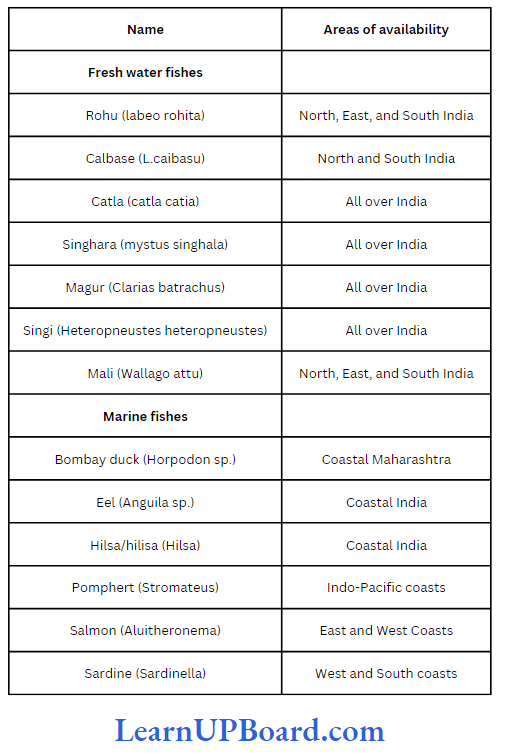
- Culture fishery: In this method, the pituitary hormone extract is injected into the male and female breeder fishes.
- Two males and one female are then kept in a breeding hapa a bamboo and cloth container.
- Spawning takes place in 3-6 h.
- Fertilized eggs are removed and kept in hatchery, where they hatch in 15-18 h.
- The hatchlings are kept in glass-jar hatcheries.
- A mouth is formed on the third day; the young fishes are now called fry.
- They are kept in rearing ponds for about 3 months where they grow into 4″-6″ long fingerlings.
- The fingerlings are then released into stocking ponds where they grow to the required size.
- In composite fish culture, different species of fish such as catla, rohu, and mrigal are cultured together.
- Types of ponds: Three types of ponds are required for the culture of the Indian major carps: nursery, rearing, and stocking ponds.
- Nursery ponds: Efficient pond fish culture requires special preparation of nurseries to receive tender hatchlings at spawn. Small and seasonal nurseries are preferred as they facilitate effective control of the environmental conditions. The steps adopted towards the preparation of nurseries are the control of predatory fishes and weeds. There should be the production of zooplankton to serve as food for spawn and control of algal blooms.
- Rearing ponds: The fries (sing. fry: young one of fish) are collected from the nursery ponds and are released in rearing ponds where they develop into fingerlings.
- Stocking ponds: The fingerlings are netted out from the rearing ponds to the stocking ponds where they change to fishes. In the stocking ponds, the fishes are kept for stocking.
- Marine fisheries: Marine fisheries are divided into coastal fisheries (about 3 miles from the coast line) and deep sea fisheries (which have different fauna of fish). In India, about 75% of the marine fish catch is from the Western coast.
- The main marine fisheries are sardines (26%), mackerel (9.7%), and the Bombay duck (11%).
- Crustacean fisheries, i.e., prawns, lobsters, crabs, and Penaeus sp. are dominant on the West coast. Mollusc fisheries include oysters, clams, mussels, squids, cuttlefish, and octopus.
- Estuarine fisheries: The place where the fresh water of rivers meets the salt water of the sea is called an estuary. It contains brackish water.
- At estuary, only those fishes of fresh water and sea can survive that can tolerate a change of salinity.
- Estuary also forms the nursery ground for several marine and fresh water species.
- Fishing on large scale from such places results in the death of a number of young and immature fishes.
- Bag nets are most commonly used in estuarine fishery.
- The major estuarine systems in India are (a) Hooghly estuary in West Bengal, (b) Mahanadi estuary in Orissa, (c) Cauvery estuary in Tamil Nadu, (d) Narmada and Tapti estuary in Gujarat, and (e) Godavari-Krishna estuary in Andhra Pradesh.
- Carp fishes such as catla (theila), Labeo rohita (rohu), Cirrhinus mrigala (mrigal), and Labeo calbasu (kalbasu) are commonly cultured together in our country.
- Such a practice of culturing together of fishes is called polyculture or composite culture.
- Important edible fishes are as follows:
- Fresh water fishes: Rohu (Labeo rohita), Calbasu (Labeo calbasu), Catla (Catla catla), Singhara (Mystus singhala), Magur (Clarias batrachus), and Singhi (Heteropneustes).
- Marine fishes: Bombay duck (Harpodon sp.), Hilsa (Hilsa sp.), Eel (Anguilla sp.), Pomphret (Stromatetis sp.), Salmon (Aluitheronema sp.), and Sardine (Sardinella sp.).
NEET Biology Notes For Strategies For Enhancement In Food Production Plant Breeding
- There are 12 mega-diversity centers in the world including India, having more than 65% global diversity. India has 7.7% genetic resources of the world.
- Agriculture originated in the Mesolithic age in New World and Old World.
- N.I. Vavilov, a Russian scientist, proposed eight cent- ers of origin of agriculture (now-a-days 12) called natural homes.
- India is the center of origin of 167 cultivated species and about 320 wild relatives of crop plants. A primary crop is a crop which came under domestication from the very beginning, e.g., wheat. Secondary crop was originally a wild relative of primary crop which was domesticated when primary crops failed.
- Monkombu Sambasivan Swaminathan (father of Green Revolution in India) initiated collaboration with Dr. Borlaug (father of Green Revolution) which reached the highest point (into the “Green Revolution”) through the introduction of Mexican varieties of wheat in India.
- Plant breeding is defined as the genetic improvement of a crop in order to create desired plant types that are better suited for cultivation, give better yields, and are disease resistant. Conventional plant breeding has been in practice since 9,000-11,000 years.
Main Steps in Plant Breeding
Following are the main steps in breeding a new genetic variety of a crop:
- Collection of variability: Collection and preservation of all distinct wild varieties, species, and relatives of cultivated species is a pre-requisite for the effective exploitation of natural genes available in the population. Germplasm is the sum total of all alleles of the genes present in a crop and its related species.
The entire collection (of plants/seeds) having all diverse alleles of all genes in a given crop is called germplasm collection. A good germplasm collection is essential for a successful breeding program. Therefore, germplasm collection is the most practical and effective answer to problems such as loss of germplasm due to expansion of agriculture, industries, and other hu- man activities. - Evaluation and selection of parents: The germplasm is evaluated to identify plants with desirable combination of characters. The selection of parents is done by picking up the seeds of only those plants for multiplication which have the desired traits.
- Common methods of crop improvement
- Selection: It is of three types:
- Mass selection: It is the simplest and the oldest method mainly for cross-pollinated crops and is based on phenotypic characters. The varieties produced by this method loose desirable qualities.
- Pure line/inbred selection: It involves isolating desirable homozygous individuals and is done for self-pollinating crops, e.g., wheat varieties PV-18, HUW-468, and Kalyan Sona.
- Clonal selection: It is used for vegetatively reproducing crops, e.g., Kufri Safed potato.
- Hybridization: It may be of the following five types:
- Intravarietal (useful for self-pollinated crops)
- Intervarictal (intra-specific), e.g., Ganga and Ranjit varieties of maize
- Interspecific: Rice variety ADT-37 (Oryza ja- ponica Oryza indices)
- Intergeneric, e.g., triticale, Raphanobrassica
- No new characters are created by hybridiza- tion.
- Mutation breeding: Various chemicals such as HNO2, base analogs, alkylating agents, acridine dyes, X rays, UV rays, and gamma rays are used to induce mutations which produce desirable qualities. It has been used commonly in self- pollinating crops. A number of new varieties have been developed such as the following:
- Sharbati Sonora and Pusa Lerma varieties of wheat (formed the basis of Green Revolution in India).
- Reimei and Atomita-2 varieties of rice.
- Erectiferum and Erectoids varieties of barley.
- Aruna variety of castor.
- Thick shell in ground nut (TGI).
- Wheat-NP 836
- Rice-Jagannath
- Cotton-Indore-2
- In mung bean, resistance to yellow mosaic virus and powdery mildew.
- Peppermint (Menthe piperita); Todd’s Mitcham variety (high oil content and disease resistant)
- Polyploid breeding: Induced polyploidy is used by plant breeders for improving the yield of for- age and other crops. Many modern day crops such as wheat, rice, sugarcane, and cotton are natural polyploids. Allopolyploids have been used for obtaining fertile hybrid between different species and genera. Allopolyploidy leads to the immediate formation of new species. For example, durum wheat, bread wheat, and triticale.
- Selection: It is of three types:
- Selection and testing of superior recombinations: The selection process yields plants that are superior to both the parents. These plants are self-pollinated for several generations till they come to a state of uniformity (homozygosity), so that the characters will not separate in the progeny.
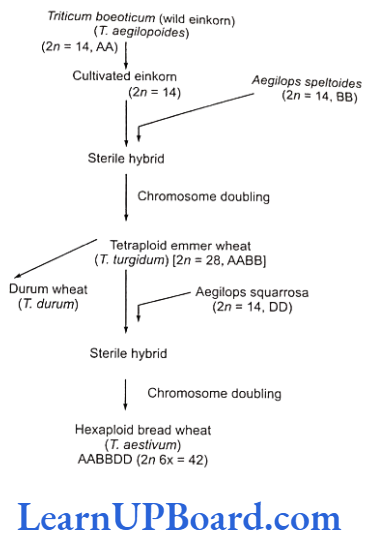
- Test, release, and commercialization of new cultivars: The newly selected lines are evaluated for their yield and other agronomic traits of quality, disease resistance, etc. This evaluation is done by growing these in the research field and recording their performance in ideal fertilizer, irrigation, etc. The testing of materials is done in the farmer’s fields, for at least three growing seasons at different locations in the country, representing all agroclimatic zones.
India is an agricultural country. Agriculture contributes about 33% of India’s GDP and gives employment to about 62% of the population. The development of several high yielding varieties of wheat and rice in 1960 increased the yields per unit area. This phase is often called Green Revolution.- Wheat and rice: From 1960 to 2000, wheat pro- duction increased from 11 million ton to 75 million ton while rice production increased from 35 million ton to 89.5 million ton. This was due to the development of semi-dwarf varieties of wheat and rice.
- Dwarf wheat: A dwarfing gene, Norin-10, was reported in Japan. American plant breeders produced single dwarf wheat. N. Borlaug of Mexico produced triple dwarf wheats, popularly known as Mexican wheats. These had high yield, resistance for lodging and common pathogens and pests, and smaller growth period. Sonora-64 and Lerma Rojo-64 were brought to India and modified through gamma mutations to make them the part of Indian agriculture. In 1963, many lines like Sonalika and Kalyan Sona were also selected as high yielding and disease resistant varieties.
- Dwarf rice: A dwarfing gene, dee-geo- woo-gen, was reported in Taiwan. It was introduced in the rice varieties by IRRI, Philippines, in varieties IR-8 and IR-24. Taichung Native-1 developed from Taiwan Jaya and Ratna were developed in India.
- Sugarcane: Saccharum barberi was originally grown in North India, but had poor sugar content and yield. Saccharum officinarum had higher sugar content and thicker stems but did not grow well in North India. These two species were crossed to obtain sugarcane varieties combining the desirable qualities of high sugar, high yield, thick stems, and ability to grow in the sugarcane belt of North India.
- Millets: Hybrid bajara, jowar, and maize have been developed in India. From hybrid varieties, the development of several high yielding varieties resistant to water stress has been possible.
- Wheat and rice: From 1960 to 2000, wheat pro- duction increased from 11 million ton to 75 million ton while rice production increased from 35 million ton to 89.5 million ton. This was due to the development of semi-dwarf varieties of wheat and rice.
NEET Biology Notes For Strategies For Enhancement In Food Production Plant Breeding For Disease Resistance
Fungal, bacterial, viral, and nematode pathogens attack cultivated crops. Due to this, there is 20-30% loss in crop yield. In such situation, if the crops are made disease resistant, food pro- duction will increase and the use of fungicides and bactericides would be reduced.
Some Important Fungal Diseases of Economically Important Plants
- Phycomycetes
- Peronospora – Downy mildew
- Pythium aphanidermatum – Damping off of seed- lings
- Phytophthora infestans – Late blight of potato
- Sclerospora graminicola – Green ear disease of bajra
- Ascomycetes
- Claviceps purpurea – Ergot of bajra
- Erysiphe Powdery mildew
- Basidiomycetes
- Puccinia graminis tritici – Stem rust or black rust of wheat
- Puccinia recondite – Leaf rust or brown rust of wheat
- Ustilago hordei – Covered smut of barley
- Deuteromycetes
- Alternaria solani – Early blight of potato
- Cercospora personata – Tikka disease of groundnut
- Colletotrichum falcatum – Red rot of sugarcane 14. Fusarium udum – Wilt of arhar
- Helminthosporium oryzae – Sesame leaf spot or brown leaf spot of rice
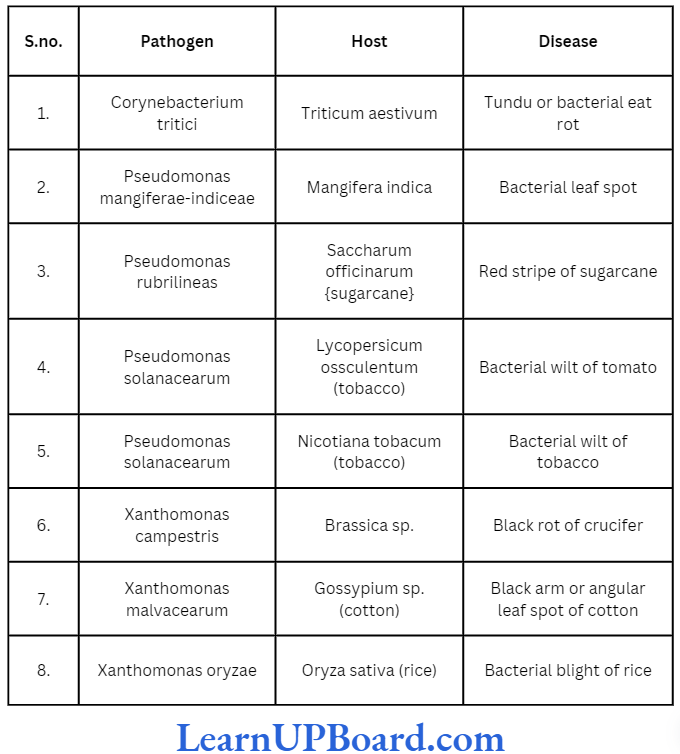
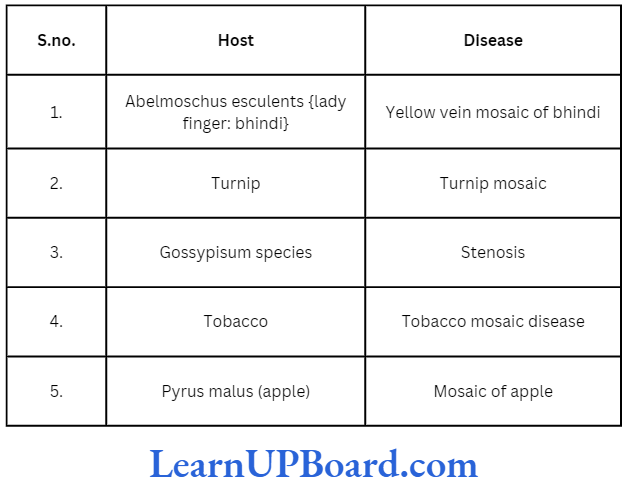
Methods of Breeding for Disease Resistance
Breeding is carried out either by conventional breeding techniques described earlier or by mutation breeding. The conventional method of breeding for disease resistance is hybridization and selection. The various sequential steps are as follows:
- Screening germplasm for resistance sources
- Hybridization of selected parents
- Selection and evaluation of hybrids
- Testing and release of new varieties
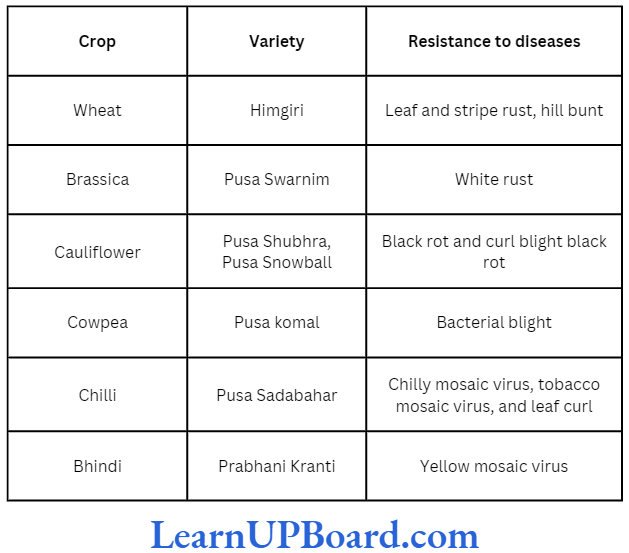
New varieties having these desirable characters can either be multiplied directly or can be used in breeding. Other breeding methods that are used are mutation, selection among soma- clonal variants, and genetic engineering.
Plant Breeding for Developing Resistance to Insect Pests
Insect and pest infections are two major causes of destruction of crop plants and crops. Insect resistance in host crop plants is due to morphological, biochemical, or physiological characters. For example, solid stem in wheat leads to non-preference by the stem sawfly; smooth leaved and nectarless cotton varieties do not attract bollworms; and low nitrogen, sugar, and high aspartic acid in maize develops resistance to maize stem.
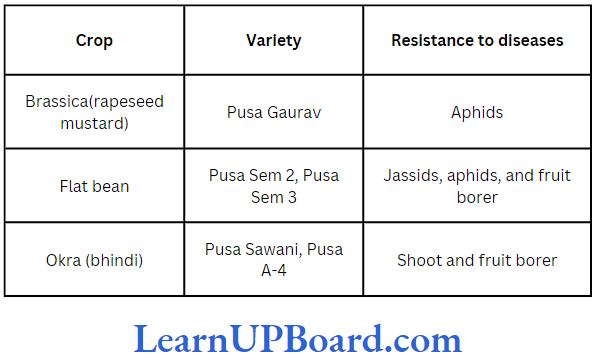
The sources of resistance genes may be cultivated varieties, germplasm collections of the crop, or wild relatives of the crop.
Plant Breeding for Improved Food Quality
It is estimated that more than 840 million people in the world do not have adequate food to meet their daily requirements. Three billion people suffer from proteins, vitamins, and micronutrient deficiencies because they cannot afford to buy adequate vegetables, fruits, legumes, fish, and meat. Breeding of crops with higher levels of vitamins and minerals or higher protein and healthier fats is called biofortification.
Plant breeding is undertaken for improving the nutritional quality of plants. The objectives are as follows:
- Protein content and quality
- Oil content and quality
- Vitamin content
- Micronutrient and mineral content
Wheat variety with high protein content (Atlas 66) has been used as a donor for improving cultivated wheat.
Indian Agricultural Research Institute (TARO), New Delhi, has developed many vegetable crops that are rich in minerals and vitamins. For example, vitamin A enriched carrots, pump- kin, and spinach; vitamin C enriched bitter gourd, bathua, to- mato, mustard, and calcium; iron enriched spinach and bathua; and protein enriched beans (broad lablab and French and gar- den peas).
Breeding for Anti-Nutritional Factors
Anti-nutritional factors are compounds present in foods that have adverse effect on animal and human growth. Some exam- ples are as follows:
- Glucosinolates are present in oils obtained from Brassica napus and are not liked by animals. Similarly, crude acid (long-chain saturated fatty acids) produces heart ailments.
- A neurotoxin, cyanoalanine, present in khesari (Lathyrus sativus) produces muscular cramps and causes lathyrism (a type of paralysis).
Crops should be free from such anti-nutritional factors. Canola is a variety of rapeseed in which genes for glucosinolates and erucic acid have been deleted.
Single-Cell Proteins
Some microorganisms such as bacteria, blue green algae, yeasts, and filamentous algae are used as food. These are called single- cell proteins (SCP). These are processed to remove excess nu- cleic acid, e.g., Spirulina, Fusarium graminearum, Chldella, Methylophilus methylotropus (source of Pruteen; 250 g of this microorganism can be expected to produce 25 ton of protein), Scenedesmus.
Tissue Culture
Plant cells and organs can be cultured in vitro on a suitable medium. Haberlandt started the technique of plant tissue culture in 1902.
The culture medium can be liquid, semi-solid, or solid. It contains source of carbon and energy (sucrose), minerals, glycine, vitamins, and growth regulators (auxin such as 2-4 D and cytokinin such as BAP).
The plant part used for tissue culture is called explant. The explant and media are sterilized before culturing. Explants are sterilized by specific antimicrobial chemicals (surface sterilization) and vessels, and media instrument with steam, dry heat, or alcohol.
Callus Culture
A small piece of parenchymatous tissue is introduced over cul-ture medium in a tube or flask in dark at 200-25°C. Within 4-6 weeks, it forms actively growing irregular and undifferentiated mass called callus. It is divided into several small sections and is sub-cultured. Each piece is then allowed to “differentiate into plantlets by providing light and morphogenetic growth hormones.
Multiple Shoot Production
It is used for raising numerous pathogen-free copies of rare plants, hybrids, and sterile plants. A shoot tip or bud with 1-4 leaf primordia is sterilized and introduced over the cul- ture medium with high salt content and naphthalene acetic acid (NAA). At an interval of 4-6 weeks, the shoot tip is given cuts or shaken to form more buds. When new plants are required, the buds are transferred to low-salt culture medium devoid of NAA. Each bud gives rise to a small plantlet.
Suspension Culture
In this technique, an explant is suspended into liquid medium containing growth regulator and is constantly agitated at the speed of 100-250 rpm (revolutions per minute). Agitation serves the following three purposes:
- Aeration of culture
- Constant mixing of medium
- Breakage of cell aggregates into smaller groups
Suspension cultures grow much faster than callus cultures. In both types of tissue cultures, with passage of time, cell/tis- sue dry matter increases and the level of nutrient decreases. To prevent the damage of newly-formed cells, parts of the cultures are regularly transferred to new culture vessels containing fresh media. This process is termed as sub-culturing.
Shoot Tip Culture or Production of Disease-Free Plants
Pathogen-free clones of plants can be obtained through shoot- tip culture because shoot apical meristem is usually free of pathogens (including virus) due to high concentration of auxins and rapid rate of cell division.. Apical meristem accompanied by 1-2 leaf primordia is taken. For this, the apical bud is steri- lized. The shoot tip is now placed over the culture medium-un- der aseptic conditions.
Somatic Embryo Regeneration
Somatic embryos are those that arise from somatic cells in tissue culture. The pattern of development of a somatic embryo proceeds through globular, heart-shaped, and torpedshaped stages and mimics the development of sexually produced embryos. Somatic embryo regeneration is induced by high con- centration of auxin. These embryos are also used to produce synthetic/artificial seeds by encapsulating them in alginate.
Embryo Culture
Embryo culture involves the exclusion of young embryo from seeds and their cultivation through tissue culture. Embryo culture has the following applications:
- In embryo rescue: Interspecific hybrids are often sterile because of embryo mortality and seed collapse. In such cases, the hybrid embryo is excised from the female parent in early stage and is cultured, e.g., common bean (Phaseolus vulpris) and wild bean (P. augustissimus).
- Embryo culture allows seeding development in plants whose seeds lack stored nutrients required for seedling growth, e.g., orchid.
- It is also used in some rare plants such as makapunonuts.
Haploid Culture/Androgenic Haploid Culture/Pollen Grain Culture
Haploid culture technique was developed by Guha and Maheshwari (1964) in Datura innoxia. Floral buds which are very young and unopened are first sterilized in Clorox for 20-40 min. These are then opened to remove anthers. Anthers are introduced over culture medium. Within 4-6 weeks, each anther gives rise to a number of haploid embryoids. Normally haploid culture produces sterile haploid plants. Colchicine treatment results in chromosome doubling and produces homozygous diploids for each and every trait. Gynogenic haploids are also possible by using unfertilized ovules.
Winter wheat Jinghua-1 and rice Guan-18 are two important varieties that are produced by this and are now under cultivation.
Uses of Androgenic Haploid
- It is useful in mutation breeding.
- Androgenic haploid is pure for its characters.
- Every gene can express in the plant.
Protoplast Fusion/Somatic Hybridization/Parasexual Hybridization
Protoplast fusion is the fusion of cells of two plants belonging to different varieties, species, and even genera. The cells are first treated with enzymes pectinase and cellulase.
These enzymes dissolve the cell walls and, as a result, naked protoplasts are produced. These protoplasts are fused by electrofusion (high-frequency alternating electric field with short current pulses) and chemofusion [through sodium nitrate or PEG (polyethyleneglycol)]. This results in hybrid protoplasts. The hybrid cell may have a synkaryon (single fused nucleus) or a heterokaryon (having two unfused nuclei).
The hybrid protoplast is called cytoplasmic hybrid or cybrid if one of its two nuclei gets degenerated. The first somatic hybrid was obtained by Carlson et. al. (1972) between Nicotiana glauca and N. langsdorfi species of tobacco. The intergeneric somatic hybrids are pomato (potato x tomato) and bomato (brinjal x tomato).
Applications of Tissue Culture
- Tissue culture can be applied for crop improvement.
- It can be applied for the rapid multiplication of desirable and rare plants.
- It can be applied to obtain indefinite number of plants.
- It can be applied to obtain virus-free plants from shoot арех.
- Somaclonal variations: These variations are produced during tissue culture. Some of these may be useful and stable, e.g., better yield and quality, male sterility, early maturation, resistance to diseases and pests, etc. Significant variations that have been taken up in plant breeding are high protein content and resistance to late blight in potato, increased shelf life in tomato, resist- ance to rust and high temperature tolerance in wheat, resistance to tungro virus and leaf hopper in rice, short duration in sugarcane, etc.
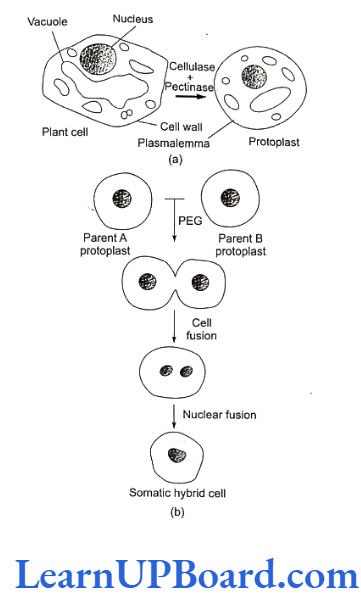
NEET Biology Notes For Strategies For Enhancement In Food Production Assertion-Reasoning Questions
In the following questions, a statement of Assertion (A) is followed by a statement of Reason (R).
- If both Assertion and Reason are true and the reason is the correct explanation of the assertion, then mark (1).
- If both Assertion and Reason are true but the reason is not the correct explanation of the assertion, then mark (2).
- If Assertion is true but Reason is false, then mark (3).
- If both Assertion and Reason are false, then mark (4).
Question 1. Assertion: Bulls not selected for breeding are castrated when young and converted to bullocks.
Reason: They are the main source of animal drought power in India.
Answer. 2. If both Assertion and Reason are true but the reason is not the correct explanation of the assertion, then mark (2).
Question 2. Assertion: Anthrax is caused by a bacterium.
Reason: Anthrax develops only in buffaloes and cannot be transferred to humans.
Answer. 3. If Assertion is true but Reason is false, then mark (3).
Question 3. Assertion: In anthrax, the animal dies due to lack of oxygen.
Reason: The anthrax bacterium uses up the oxygen carried by the animal blood.
Answer. 1. If both Assertion and Reason are true and the reason is the correct explanation of the assertion, then mark (1).
Question 4. Assertion: Cattle breeds can be improved by super ovulation and embryo transplantation.
Reason: Super ovulation in high milk yielding cows is induced by hormonal injection.
Answer. 2. If both Assertion and Reason are true but the reason is not the correct explanation of the assertion, then mark (2).
Question 5. Assertion: Honey is an animal product produced by honey bee.
Reason: Honey contains only sugar, nothing else.
Answer. 3. If Assertion is true but Reason is false, then mark (3).
Question 6. Assertion: India ranks fifth in the world in catile population but figures poorly in milk production.
Reason: Buffaloes give more milk with higher fat and mineral contents than cows.
Answer. 2. If both Assertion and Reason are true but the reason is not the correct explanation of the assertion, then mark (2).
Question 7. Assertion: Poultry farming has definite advantage over livestock rearing.
Reason: Poultry birds are easy to raise, can be acclimatized to a wide range of climatic conditions, have short lifespan, and are prolific breeders.
Answer. 1. If both Assertion and Reason are true and the reason is the correct explanation of the assertion, then mark (1).
Question 8. Assertion: Encephalomalacia, a disease of poultry, is caused by the protozoan Eimeria.
Reason: Encephalomalacia causes bloody diarrhea in poultry.
Answer. 4. If both Assertion and Reason are false, then mark (4).
Question 9. Assertion: Fish meal is a rich source of protein for cattle and poultry.
Reason: Fish meal is prepared from the non-edible parts of fishes such as tails, fins, and bones.
Answer. 2. If both Assertion and Reason are true but the reason is not the correct explanation of the assertion, then mark (2).
Question 10. Assertion: Somatic hybrids may be used for the production of useful plants.
Reason: Genetic manipulation can be carried out more rapidly when plant cells are in protoplast state.
Answer. 1. If both Assertion and Reason are true and the reason is the correct explanation of the assertion, then mark (1).
Question 11. Assertion: Callus is obtained within 2-3 weeks.
Reason: Suspension culture grows much faster than callus culture.
Answer. 2. If both Assertion and Reason are true but the reason is not the correct explanation of the assertion, then mark (2).
Question 12. Assertion: Genetic improvement of the crop is plant breeding.
Reason: It creates desired plant types that are better suited for cultivation.
Answer. 2. If both Assertion and Reason are true but the reason is not the correct explanation of the assertion, then mark (2).
Question 13. Assertion: The phase between 1960-1970 is often called the Green Revolution.
Reason: The development of several high yielding varieties of wheat and rice in 1960’s increased yields per unit area.
Answer. 1. If both Assertion and Reason are true and the reason is the correct explanation of the assertion, then mark (1).
Question 14. Assertion: The maize having high nitrogen, sugar, and aspartic acid is resistant to pest.
Reason: It develops resistance to maize root borers.
Answer. 4. If both Assertion and Reason are false, then mark (4).
